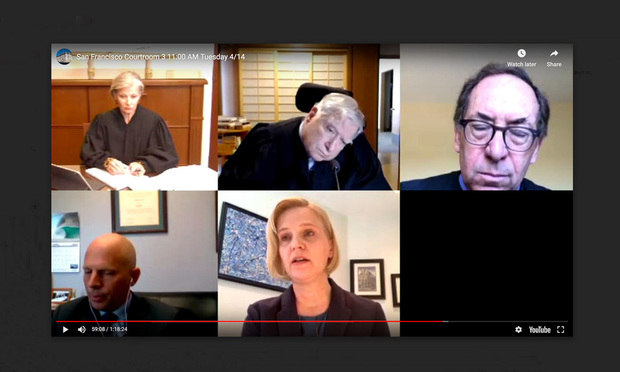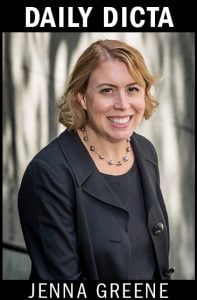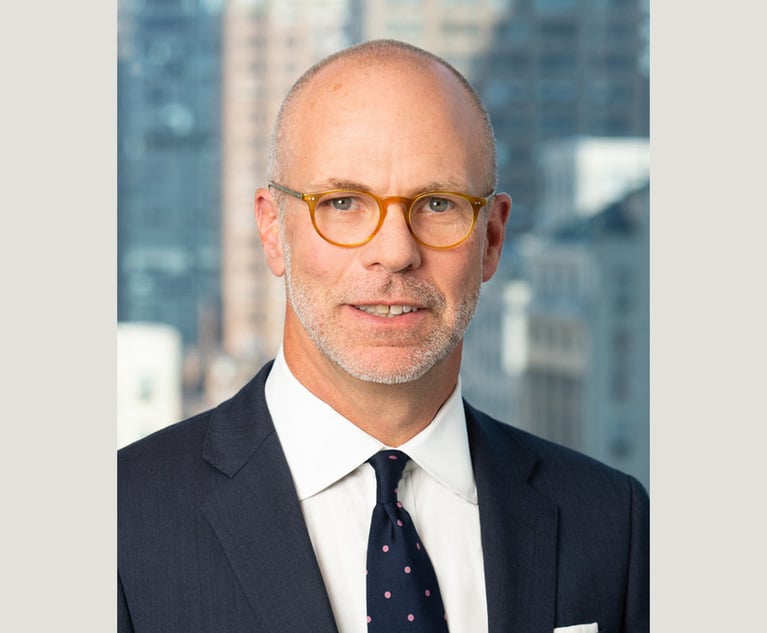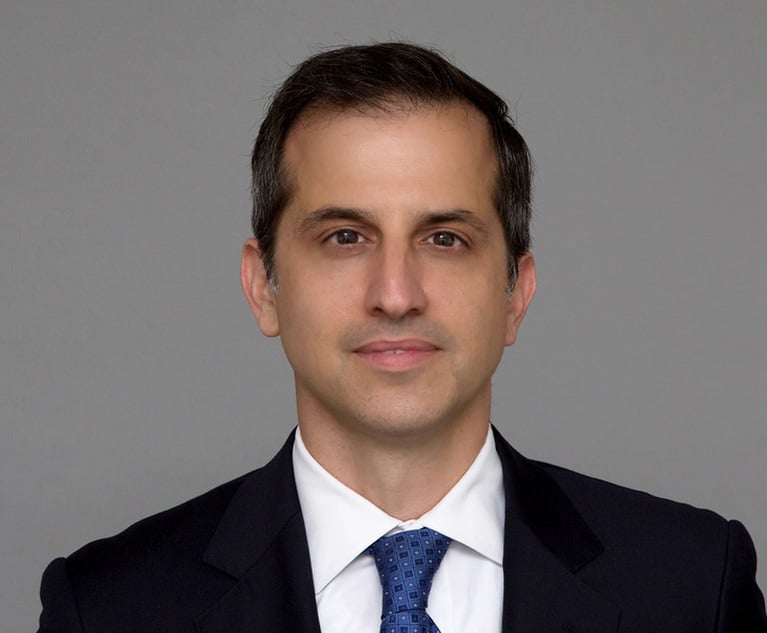Daily Dicta: Class Action Objectors Can Be Annoying—But This One Has a Point
It's not that Hagens Berman doesn't deserve its $48M fee—they make a strong case for why they earned every penny. But at the same time, shouldn't the firm's initial promise to work for less count for something?
April 15, 2020 at 12:14 AM
5 minute read
 Ninth Circuit You Tube argument
Ninth Circuit You Tube argument
When plaintiffs lawyers from Hagens Berman Sobol Shapiro made their pitch in 2010 to be appointed lead class counsel in a massive price-fixing conspiracy involving the sale of optical disk drives, they offered to work for a bargain-basement rate.
In a sealed bid submitted to now-retired U.S. District Judge Vaughn Walker of the Northern District of California, they laid out a sliding-scale 11% fee. That would have worked out to a $22.6 million payday after they notched a series of settlements totaling $205 million.
Instead, Hagens Berman has been awarded more than twice as much—$47.78 million by U.S. District Judge Richard Seeborg, who took over the matter from Walker when he retired in 2011.
One class member is crying foul, calling it a "bait-and-switch at the expense of the class."
Objector Conner Erwin has got a point. It's not that Hagens Berman doesn't deserve the fee—they make a strong case for why they earned every penny. But at the same time, shouldn't the firm's initial promise to work for less count for something?
 On Tuesday, the U.S. Court of Appeals for the Ninth Circuit heard arguments via Zoom—and hinted that it may remand the case, though perhaps only to consider the portion of the award covering expenses.
On Tuesday, the U.S. Court of Appeals for the Ninth Circuit heard arguments via Zoom—and hinted that it may remand the case, though perhaps only to consider the portion of the award covering expenses.
It's a novel issue for the appellate court. As Judge Morgan Christen (above, top left) put it, "This will be an opportunity for us to provide more guidance," she said. "Should a fee bid be a Vizcaino factor that must be considered?"
If the underlying case sounds familiar, it's probably because hordes of Am Law 100 firms were on the other side representing defendants including Sony, Hitachi, Philips, Samsung and Toshiba.
Firms listed on the docket include Latham & Watkins; O'Melveny & Myers; Boies Schiller; Baker Botts; Katten Muchin; Winston & Strawn; Sheppard Mullin; Kasowitz; Blank Rome; Jones Day; Shearman & Sterling; Davis Polk; Gibson Dunn; Ropes & Gray and more.
Their clients were accused of fixing prices for optical disc drives in computers, DVD and Blu-Ray players in the 1990s and 2000s. The ODDs were used for storing data, music, and other multimedia files.
Hagens Berman beat out a competing bid by a group of more than a dozen plaintiffs firms led by Stephen Larson of Griardi Keese and another bid by Zelle Hofmann Voelbel & Mason to represent a class of 107 million consumers who bought the devices.
But Hagens Berman partner Shana Scarlett (bottom ,middle) stressed to the Ninth Circuit panel, which also included Judge Ronald Gould (top middle, who suffers from MS) and U.S. District Judge Robert Lasnik (top right) sitting by designation from the Western District of Washington, that litigating the case was a massive undertaking.
There were "dozens of hearings of discovery disputes … two rounds of motions for class certification and an extraordinary number of motions for summary judgment," she said. Indeed, there are nearly 3,000 entries in the lower court's docket.
Scarlett also noted that Seeborg in awarding the fees praised Hagens Berman's "excellent work in this case," and described the litigation as "extraordinarily difficult."
When Judge Walker picked lead counsel, she continued, he "never ruled that he saw that Hagens Berman was bound by a single data point. … Instead, it was an interim order of the court, that it had the inherent authority to modify at any time under Rule 54(b)."
The fee bid was simply "one data point" to consider at the end of the case, Scarlett said—and Seeborg concluded that it was not dispositive.
Instead, she said, Seeborg "went to extraordinary lengths" to consider other factors in awarding the fee, including the results achieved, whether the case was risky, the market rate for antitrust cases and whether the case was handled on a contingency basis.
Moreover, the court found that the class counsel's requested fee was reasonable under both the percentage-of-fund and lodestar methods. It's not as if Hagens Berman got some crazy windfall.
But Robert Clore of the Bandas Law Firm (bottom, ,left) representing objector Conner Erwin argued that Seeborg didn't even look at the firm's original bid before awarding the bulk of the legal fees. In fact, the judge initially couldn't even find a copy of it, Clore said.
At a minimum, he argued, the Ninth Circuit should remand the case to require Seeborg to "at least articulate his analysis for declining to apply the bid."
Clore also stressed that the bid specifically promised "no separate expense award would be made on top of any-percentage-based fee award."
Hagens Berman was awarded more than $5 million in expenses.
Scarlett countered that this provision actually referred to "taxation of costs"—a specific and enumerated list that's separate from expenses.
But Lasnik was not persuaded. "I think Judge Walker understood costs to be expenses," he said. "I as a district court reviewing that would have thought costs were expenses."
Taxable costs, he continued, "are a meager amount of money but expenses are something significant. This is an area where I am casting aspersions on Hagens Berman. … We might need a little more clarification from Judge Seeborg about what he did in that area."
This content has been archived. It is available through our partners, LexisNexis® and Bloomberg Law.
To view this content, please continue to their sites.
Not a Lexis Subscriber?
Subscribe Now
Not a Bloomberg Law Subscriber?
Subscribe Now
NOT FOR REPRINT
© 2025 ALM Global, LLC, All Rights Reserved. Request academic re-use from www.copyright.com. All other uses, submit a request to [email protected]. For more information visit Asset & Logo Licensing.
You Might Like
View All
2024 Marked Growth On Top of Growth for Law Firm Litigation Practices. Is a Cooldown in the Offing for 2025?

Big Company Insiders See Technology-Related Disputes Teed Up for 2025

Litigation Leaders: Jason Leckerman of Ballard Spahr on Growing the Department by a Third Via Merger with Lane Powell
Law Firms Mentioned
- Davis Polk & Wardwell
- Latham & Watkins
- Zelle Hofmann Voelbel
- Sheppard, Mullin, Richter & Hampton
- O'Melveny & Myers
- Winston & Strawn LLP
- Baker Botts
- Boies Schiller Flexner
- Katten Muchin Rosenman
- Hagens Berman Sobol Shapiro, LLP
- Jones Day
- Gibson, Dunn & Crutcher
- Blank Rome
- Ropes Gray
- Shearman & Sterling LLP
Trending Stories
- 1The Rise and Risks of Merchant Cash Advance Debt Relief Companies
- 2Ill. Class Action Claims Cannabis Companies Sell Products with Excessive THC Content
- 3Suboxone MDL Mostly Survives Initial Preemption Challenge
- 4Paul Hastings Hires Music Industry Practice Chair From Willkie in Los Angeles
- 5Global Software Firm Trying to Jump-Start Growth Hands CLO Post to 3-Time Legal Chief
Who Got The Work
J. Brugh Lower of Gibbons has entered an appearance for industrial equipment supplier Devco Corporation in a pending trademark infringement lawsuit. The suit, accusing the defendant of selling knock-off Graco products, was filed Dec. 18 in New Jersey District Court by Rivkin Radler on behalf of Graco Inc. and Graco Minnesota. The case, assigned to U.S. District Judge Zahid N. Quraishi, is 3:24-cv-11294, Graco Inc. et al v. Devco Corporation.
Who Got The Work
Rebecca Maller-Stein and Kent A. Yalowitz of Arnold & Porter Kaye Scholer have entered their appearances for Hanaco Venture Capital and its executives, Lior Prosor and David Frankel, in a pending securities lawsuit. The action, filed on Dec. 24 in New York Southern District Court by Zell, Aron & Co. on behalf of Goldeneye Advisors, accuses the defendants of negligently and fraudulently managing the plaintiff's $1 million investment. The case, assigned to U.S. District Judge Vernon S. Broderick, is 1:24-cv-09918, Goldeneye Advisors, LLC v. Hanaco Venture Capital, Ltd. et al.
Who Got The Work
Attorneys from A&O Shearman has stepped in as defense counsel for Toronto-Dominion Bank and other defendants in a pending securities class action. The suit, filed Dec. 11 in New York Southern District Court by Bleichmar Fonti & Auld, accuses the defendants of concealing the bank's 'pervasive' deficiencies in regards to its compliance with the Bank Secrecy Act and the quality of its anti-money laundering controls. The case, assigned to U.S. District Judge Arun Subramanian, is 1:24-cv-09445, Gonzalez v. The Toronto-Dominion Bank et al.
Who Got The Work
Crown Castle International, a Pennsylvania company providing shared communications infrastructure, has turned to Luke D. Wolf of Gordon Rees Scully Mansukhani to fend off a pending breach-of-contract lawsuit. The court action, filed Nov. 25 in Michigan Eastern District Court by Hooper Hathaway PC on behalf of The Town Residences LLC, accuses Crown Castle of failing to transfer approximately $30,000 in utility payments from T-Mobile in breach of a roof-top lease and assignment agreement. The case, assigned to U.S. District Judge Susan K. Declercq, is 2:24-cv-13131, The Town Residences LLC v. T-Mobile US, Inc. et al.
Who Got The Work
Wilfred P. Coronato and Daniel M. Schwartz of McCarter & English have stepped in as defense counsel to Electrolux Home Products Inc. in a pending product liability lawsuit. The court action, filed Nov. 26 in New York Eastern District Court by Poulos Lopiccolo PC and Nagel Rice LLP on behalf of David Stern, alleges that the defendant's refrigerators’ drawers and shelving repeatedly break and fall apart within months after purchase. The case, assigned to U.S. District Judge Joan M. Azrack, is 2:24-cv-08204, Stern v. Electrolux Home Products, Inc.
Featured Firms
Law Offices of Gary Martin Hays & Associates, P.C.
(470) 294-1674
Law Offices of Mark E. Salomone
(857) 444-6468
Smith & Hassler
(713) 739-1250







